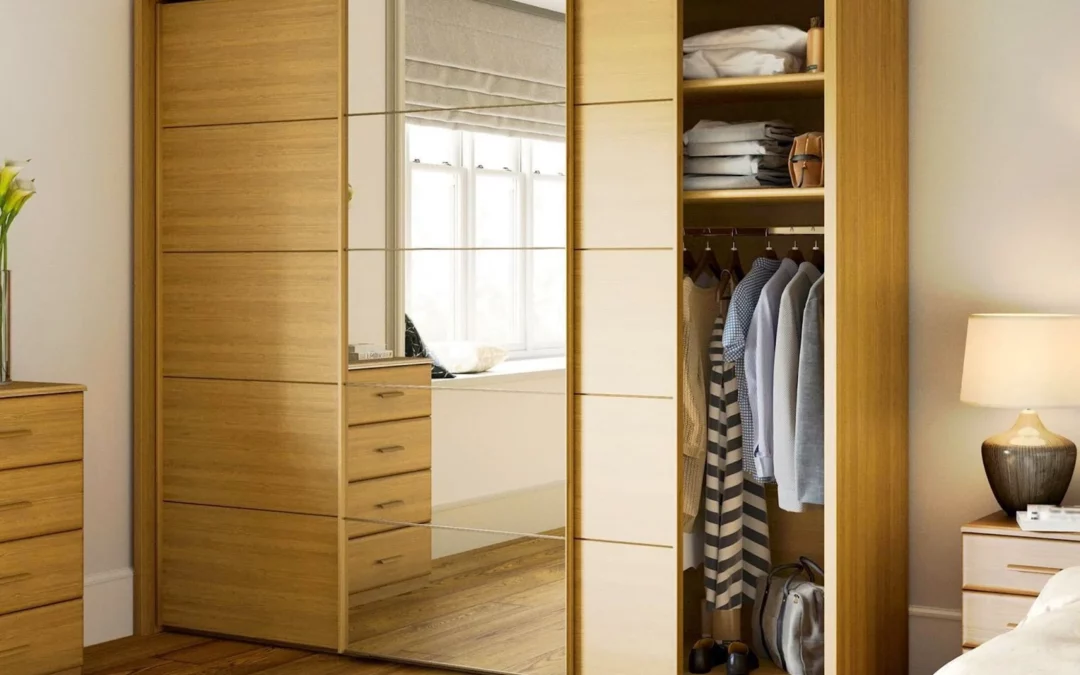As the days start to get colder, our homes become more vulnerable to the damp, something which can easily ruin your bespoke wardrobe. Whether you have a fitted wardrobe, walk in wardrobe, or a wardrobe with sliding doors, it’s important that take the right precautions when caring for them in the colder months, to make sure they do not suffer from any damage.
To help you stay one step ahead of the game, we’ve listed a few of our top tips in protecting your wardrobe from the harsh realities of the winter months.
Causes and Effects of Damp in Wardrobes
Damp in wardrobes is caused by excessive moisture, often due to poor ventilation, condensation, leaks or simply high humidity. This damp environment allows mould, mildew and other fungi to thrive. The effects of damp in a wardrobe can be very damaging – clothes become stained, smell musty and may rot or disintegrate over time. Moths, silverfish and other fabric-feeding insects also love the damp conditions.
Within the wardrobe itself, metal components like zips and fixtures will rust, while wooden surfaces and paintwork peel and warp. Overall, damp causes considerable damage both to clothes stored in the wardrobe and the wardrobe structure itself. Preventing and rectifying damp is essential for protecting your wardrobe contents.
How to Prevent Damp from Occurring
The key to preventing damp in wardrobes is regulating moisture levels through proper ventilation, dehumidification, and eliminating sources of moisture. Open windows regularly to allow fresh air circulation and prevent buildup of condensation. Use a dehumidifier to actively control humidity.
Check for leaks around pipes or windows and repair any water damage immediately. Insulate cold external walls, as the temperature differential can cause water vapour in warm air to condense on cold surfaces. Take these proactive moisture control measures to ensure your wardrobe maintains a dry environment inhospitable to mould growth. With vigilant prevention, you can stop damp from taking hold and creating the associated musty smells and fabric damage.
When Damp Causes Damage
Take note of these suggestions for when damp has already caused damage to your wardrobe.
- For mildew stains:
- Wash clothes in hot water to kill mould spores
- Dry thoroughly in direct sunlight to prevent re-growth
- Repeat the process if stains persist
- For small damp patches:
- Freeze the affected area overnight to kill mould
- Once thawed, air out the clothing outside
- Use a stiff brush to remove any dead mould
- Wash and dry as normal to freshen
- For larger stained areas:
- Rewash and spot-treat stains with white vinegar or bleach
- Vinegar kills mould while bleach removes discoloration
- May need to soak the stained area beforehand
- Repeat washes if the stain remains
- For severely damaged items:
- Check if the fabric is rotting or has large stained patches
- Consider cutting away truly damaged sections
- If the item is unsalvageable, throw it away
- Replace severely affected garments
It’s very important to act quickly at first signs of damage before mould spreads.
How to Protect Clothing from Existing Damp
If damp has already taken hold in your wardrobe, the key is to limit its impact on clothes. Store fabrics in breathable materials like cotton rather than plastic to allow airflow. Use moisture-absorbing products like silica gel sachets in drawers and wardrobe corners. Frequently air out clothing and rotate items from the back to the front of the wardrobe.
Thoroughly clean drawers and wardrobe interiors to prevent mould buildup. Consider using mothballs, as the strong scent deters mould and mildew growth. Take affected clothes out of the damp wardrobe to dry fully, brushing and airing them before returning them to the wardrobe. These measures will help protect your clothes from further damage due to existing damp conditions while you address the underlying moisture issue.
Advantages of a Professionally Installed Fitted Wardrobe
Here are some key advantages of using a professional wardrobe manufacturer to build a bespoke fitted wardrobe when it comes to preventing damp issues:
- Expertise in moisture control – They understand vapour barriers, insulation, ventilation etc.
- Quality materials – They will use moisture-resistant products like marine plywood.
- Precise sizing – A made-to-measure wardrobe fills the space exactly, leaving no gaps where condensation can form.
- Sealed units – Doors and drawers will seal tightly, preventing humid air getting in.
- Integrated dehumidifiers – Many have built-in dehumidifying systems to actively control moisture.
- Slope-roof tops – Angled tops prevent condensation drips from leaks.
- Waterproof backing – Quality wardrobes have water-resistant lacquered backs.
- Professional installation – Experts will properly seal edges and ensure water-tightness.
- Ongoing support – If issues do arise, they have the expertise to address it.
The right bespoke fitted wardrobe is designed from the ground up to create a dry, well-ventilated storage space that actively resists damp. This provides the ideal storage environment to protect precious clothes.
Where To Order a Bespoke Fitted Wardrobe
For the ultimate custom-made wardrobe that will protect your clothes from damp, consider ordering a bespoke fitted wardrobe directly from our specialist joinery workshop. We craft beautiful made-to-measure wardrobes suited to your space and style preferences using high quality moisture-resistant materials.
Our experts will provide full installation instructions tailored to your room’s dimensions to ensure a perfect fit. For an all-inclusive service, we also offer professional fitting by our trained wardrobe installers who will seal and integrate your wardrobe to the highest standard.
Invest in the damp-proofing properties of a bespoke wardrobe and avoid mouldy, mildewed clothes and deterioration of your storage space. Contact us today to discuss designing your ideal fitted wardrobe.



Recent Comments